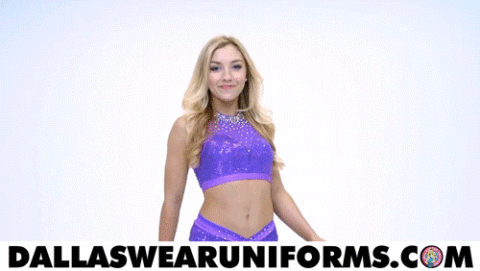 In “It’s Not About the Pom-Poms,” Laura Vikmanis shares her story of how she achieved her dream of becoming a professional cheerleader against some formidable odds and without compromise. Here’s an excerpt.
In “It’s Not About the Pom-Poms,” Laura Vikmanis shares her story of how she achieved her dream of becoming a professional cheerleader against some formidable odds and without compromise. Here’s an excerpt.
MSNBC
3/19/2012
The Tunnel
We burst out of the locker room and head down the narrow white hallway in pairs, talking and giggling. I am so nervous, my palms are wet and I have to blot them against my thighs so I won’t stain my miniskirt. We’re going over moves and checking one another’s faces. “Don’t let me forget that head flip!” “Remind me to move out of the way on our second formation change.” “Which arm goes up first on the intro dance?” “Do I have lipstick on my teeth?” “Does my bra show?” “Does my second bra show?” “Is my eyelash falling off?”
The narrow hallway leads to the wide underbelly of Paul Brown Stadium. This part of a football stadium is not glamorous—it’s gray and dingy, with exposed pipes and cinder block walls—but on Game Day it’s kinetic, so packed with people that it’s like the backstage of a Broadway musical. Our black, orange, and gold pom-poms swaying as we walk, we pass the security guys, the referees, coaches, reporters, cameramen, and the pyrotechnicians who are readying the fireworks equipment. I look at the other girls in their halter tops and low-slung skirts and realize, I’m one of them. I look like that, too.
The girls and I have known one another just a few months but it feels like we’ve been through combat training. In some ways we have. We have made it through three rounds of competitive tryouts, a summer of exhausting practices, constant dieting, twice-a-week weigh-ins, and brutal athletic conditioning. Now it’s all about to pay off, as we cheer the first home game of the preseason. It’s August 27, 2009, and the Cincinnati Bengals are playing the St. Louis Rams. But if you had asked me right then, in the passage of the stadium, who our opponents were, I would have had to think twice before answering. For us the games are not about the opponents or the score, though cheering is always more fun when we’re winning. They are about performance. The games are our shows and the field is our stage.
Like all modern cheerleading teams, we are a physically diverse group of women. Some of us are lithe, others petite and muscular. Some are curvy, some thin as a rail, some have legs that go on forever. Some are brunette, some blonde, some redheaded. Most are white, but our group includes an Asian American girl, two African American girls, and a pretty blonde who is part Cherokee.
I am different from all of these girls in one significant way: I am forty years old.
As we near the tunnel, people grin or ogle or give us the thumbs-up. Everyone smiles around cheerleaders, it’s Pavlovian. We’re iconic, beautiful, and fit, but we’re also over the top. We know it, we don’t mind, it’s why we’re here.
A group of fans is taking a tour of the stadium, led by an official. They can’t stop staring. We don’t stop to chat; we don’t have time. I’m going over my moves in my head. Each one of us is nervous about something different. I think I’m going to throw up. Why didn’t I pee before we left? What do I do on the second eight-count of “Welcome to the Jungle”?
Thirty-two of us have shown up to the stadium today but only twenty-four of us are on our way to the field. The others are upstairs working the private suites. I have been selected to cheer because I’m a good dancer, I’m consistently on time, and I always make my weight limit, one hundred twenty-three pounds for my five-foot-four-inch frame.
Our Game Day uniform, which we take home after every game and must return when we retire from the team, is a micro miniskirt in orange and black, and a white-and-orange halter top with a rhinestone B between the breasts. We wear calf-high, low-heeled white leather boots, shipped to us from a small shop in Los Angeles. (They are the only thing I will get to keep at the end of the season.) Beneath our skirts, which have a built-in panty, our legs are encased in suntan color L’eggs Sheer Energy panty hose with the waistband removed so we don’t have muffin tops, and the toes cut off so we have circulation.
We are all wearing tan, heavy foundation, fake eyelashes, and French-manicured or clear-polished nails, as required by our rulebook. Some of us have foundation or powder on our stomachs to give us great abs, whether we really have them or not. If you took all the silicone bra inserts, which we call chicken cutlets, that girls have stuffed inside their halters and put them in a pile, it would be about the size of a linebacker. I myself need no chicken cutlets; I got breast implants almost a year before, as part of the same midlife crisis that led me to believe I could get on the Ben-Gals in perimenopause. Real or fake, each set of boobs is pressed together and up.
On our mouths we wear a hideous bright orange lipstick—Orange Flip by Revlon. It makes you look like someone’s pushy grandmother who leaves kiss marks on your cheeks after she greets you. The Ben-Gals have been wearing it for decades.
We pass the players’ locker room, which always feels forbidden. Cheerleaders are not allowed to enter the room at any point. I have memorized the white sign on the door: notice! no person except authorized club and league personnel and accredited members of the media shall be permitted to enter the locker room of any participating club on the day of the game. The locker-room door is connected to the tunnel by a “yellow brick road.” It’s not really yellow but a gray, black, and orange pattern that leads the boys to the field before a game and from the field after a nail-biting victory or humiliating loss. We are not allowed to step on the road lest we get in their way.
The boys are streaming in on their way back to the locker room after their warm-up exercises. Chad Ochocinco (who changed his last name from Johnson to Ochocinco to match his jersey number, eighty-five) and Dhani Jones are coming toward us. We avert our eyes, not wanting to distract them, but we peek at their faces to gauge their pregame state of mind. It’s almost seven-thirty at night but we have been at the stadium over four hours— practicing, eating an early dinner, and getting ready. We have been here longer than some of the players.
We form small groups, touching our toes and doing lunges, warming up our muscles. We arrange ourselves into a circle to the side of the Bengal brick road and say a quick prayer, led by Tara, our captain, a leggy brunette with deep, dark-brown eyes, a straight little nose, and wavy hair so long it touches her elbows. We stand shoulder to shoulder, cross our arms in front of our chests, and link pinkies, because our poms (cheerleaderspeak for “ pom-poms”) prevent us from holding hands. Tara lowers her head and says, “Lord, thank you for allowing us to be here today and for keeping us safe. Make sure the fans are safe, the players are safe, and we are safe. Make sure everyone gets home all right after the game. Thank you for making sure that we have no injuries, and for allowing us to cheer.”
“Amen,” we say in unison.
We all stand, hands on hips, and bend our right knees. This is Ben-Gal Pose. We will do it a hundred more times over the course of the game, at the end of our short dances, the “fillers.” We shake our poms just below our breasts and say “Yay!” quietly, so as not to disturb the officials around us.
Then we go into the tunnel. I get chills. It’s short, maybe forty feet or so, just a passage with air vents, decorated with Bengals banners, but it feels holy to me. Through the opening I can see fifty-two thousand Bengal fans in the seats, drinking beer, cheering, thrilled to be back for another season, praying that the team can do better than the four-eleven-and-one record it had in 2008. Electric energy radiates from the stands because hopes are always highest at the beginning, and not in the middle, of a Bengals season. My sister, brother-in-law, boyfriend, mom, and two daughters are here. I can hear the public address announcer Bob Kinder in the background, talking about the game. The neon yellow-green goalpost is bright against the sky. A Bud Light ad is to the left, a Pepsi ad to the right.
We stand in two lines. All around me, hair is flying, poms are shaking. Orange Flip flashes over artificially whitened teeth. Fans are leaning their heads over the tunnel wall, screaming and clapping. I start tearing up. Remember this. This is real.
Bob Kinder is saying, “Here are your 2009 Cincinnati Ben-Gals!” The crowd goes crazy, cheering. We walk onto the field, chins high, smiling, past the officials, the photographers, and the video cameras, to the middle—right on the Bengal tiger.
Our intro dance is a revue that includes an “Eye of the Tiger” remix, Cobra Starship’s “Good Girls Go Bad,” and LL Cool J’s “Move Somethin’.” The synthesizer chords are booming through the $1.7 million video and sound system. “Back, back, back/Risin’ up.” We start to move. The fans’ favorite part is the kick line, when we arrange ourselves like the Rockettes on the hash marks. My chin is raised to the sky, so even the fans in the top tiers, thousands of feet away, feel like I’m performing for them. “Snotty, snotty,” Tara always tells us. “You’re smiling but be a little snotty.”
From the other end of the line, Tara’s yelling, “Back up, Brandy! Laura, half-step forward!” We can yell at each other during dances, but we always smile so no one can tell. I’m kicking in sync with the other girls. For these four minutes everyone’s attention is on us— unlike during the game, when many fans will glance over our heads in annoyance to the action on the field, seeing us as a distraction.
We ripple. We do high kicks. As my leg shoots out in front of me, I think about what it took for me to get here. Seconds pass and the music and crowd begin to fade out, until my head is silent. I am no longer on the field of Paul Brown Stadium. I’m an hour away and seventeen years younger, inside the ugly yellow house. I am a twenty-three-year-old newlywed, locked inside a bedroom, desperate to escape, and the only way out is to kick.
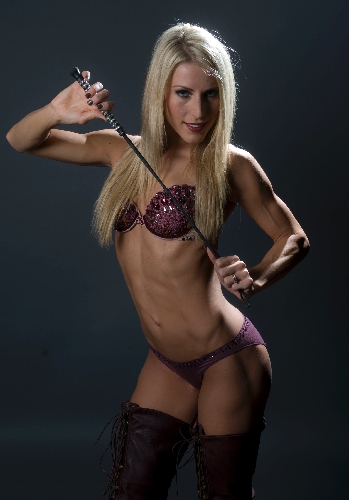 By John Przybys
By John Przybys
Las Vegas Review-Journal
Feb. 12, 2012
Q: What part do you play in “Peepshow”?
A: I have a featured role. Her name is Lady Cross, and she’s one of the fairy tale nursery rhymes we use that sort of bring Bo Peep on the journey of discovering herself as a woman.
Q: How long have you been dancing?
A: I started dancing when I was 2. (Laughs) When I was potty trained, whenever that is, although, my daughter (Blake) is not quite 3 and she’s been in dance almost a year. But I always loved dancing. I always knew it would be a part of my life.
Q: You used to be a cheerleader for the New England Patriots. What was that like?
A: The NFL experience was one of my best professional experiences, for sure. Not only do I love performing, but I traveled the world.
Q: And, then, the New York Knicks?
A: The Knicks. I went to school in New York for a while and did a lot of commercial work and a lot of auditions. I sang for a while in a cover band, and that was kind of nice. (Laughs) My days of trying to be a rock star were awesome. Anything just performing in general is something I’ve been doing since I was 5.
Q: What brought you to Las Vegas?
A: Actually, it was 100 percent for my husband’s performance. (Justin is) a drummer in a show. He’s founder, creator, drummer and performer in “Recycled Percussion” at the Tropicana. … So we came out here. My baby was 6 months old at the time, so I was just getting back into, “OK, what am I going to do?” and Vegas ended up being a good place for both of us to pursue what we both love to do.
Q: It sounds like it’s working out well.
A: It’s great. … I’ve found that it’s just a real good balance between what I love to do — perform and still have my own career and find my own independence — but maintaining my family as my top priority. My daughter, I get to spend all day with her to go to the park, go to the library, go to dance class. I can spend 100 percent of my time on her and then, at night, go to work for a few hours, be in character and then go home to tuck her into bed.
Q: NFL cheerleading versus performing in “Peepshow” …
A: It’s so different. My gosh, you’re talking about performing for 70,000 people in Gillette Stadium. But we were on the sidelines … you’re not the focus of attention, whereas (in “Peepshow”) you’re performing in a beautiful theater and for people who are paying to come to see that show and to see you, which is a very humbling and exciting thing.
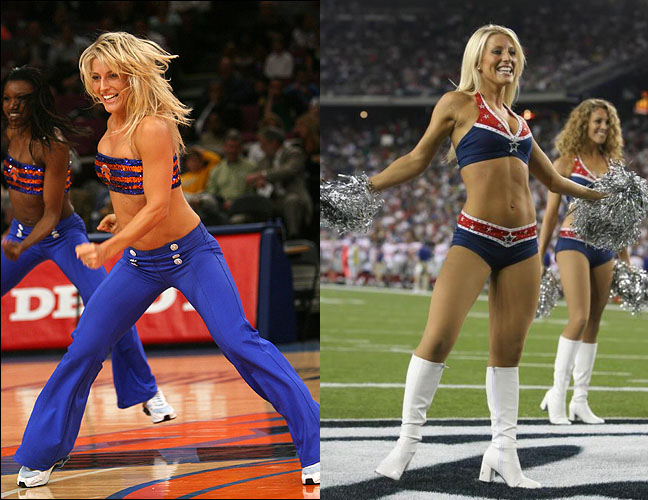
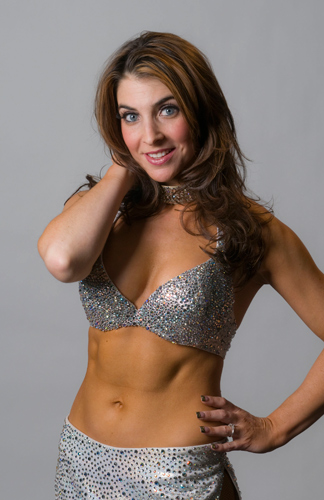 By John Przybys
By John Przybys
Las Vegas Review-Journal
Jan. 6, 2012
Q: You’ve been dancing since you were a kid. What’s the appeal?
A: I just definitely liked to be on stage and perform. It was just a passion that I had, and it’s something that I’m very happy has stayed with me. I’ve had great teachers and met amazing people and earned opportunities that have really enriched my life.
Q: Did you always want to make dancing your career?
A: In, like, sixth grade, I wanted to be an astronaut, actually. I was really into math at that time and I built Skylab for a science fair project. But as math continued, it was, like, “Ohhh, this is a lot of school.” So I got more into my dance and my cheer(leading) and all these fun things, and I thought, “Wow, this is fun. Know what? I’m gonna make a career of this.”
Q: And you became a dancer at Studio 54 (at the MGM Grand).
A: I started there in ’99 (as a dancer) … Then, they had an acrobat couple who were doing a few different things, and decided to do “The Stars of 54.” They created this (aerial) act which was three stars — three different points in the club, so it would be a trio act.
Q: How high up are we talking?
A: It’s, like, 20 feet? It’s definitely a nice, comfortable height for me.
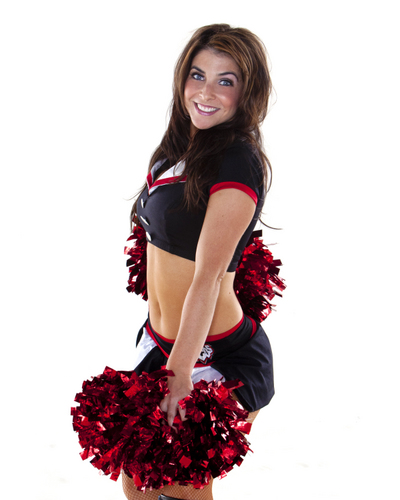 Q: You’ve also been a cheerleader for three Las Vegas pro football teams (the XFL Outlaws, the AFL Gladiators and the UFL Locomotives). Who’s crazier: Drunken football fans or drunken nightclub guys?
Q: You’ve also been a cheerleader for three Las Vegas pro football teams (the XFL Outlaws, the AFL Gladiators and the UFL Locomotives). Who’s crazier: Drunken football fans or drunken nightclub guys?
A: It’s a different spectrum. The comments you hear from football fans and the comments you hear from club fans are different. But they all have a good time … We’ve often thought of keeping a book of all the pickup lines we’ve been asked.
Q: What’s the weirdest line you’ve ever heard?
A: Last night, actually, I had somebody who wrote down their name and room number, and then put “flexible” underneath it. I was, like, flexible like “I don’t care if you’re married or single” or “flexible if you want to bring someone else,” or flexible as in “You can just do an act yourself.” You just never know.
Q: Studio 54 is set to close on Feb. 4. What’s the home stretch like for you?
A: There are no words. It’s not just the place you go to five days a week. … So it’s definitely something close to my heart and I’m sad to see it go. I met my husband there and spent a lot of my life there. It’ll be a change, but, you know, everything comes to an end.
Check out my homie Anncell and Her teammates on this week’s Sports Illustrated’s NBA dance team gallery! Click here.
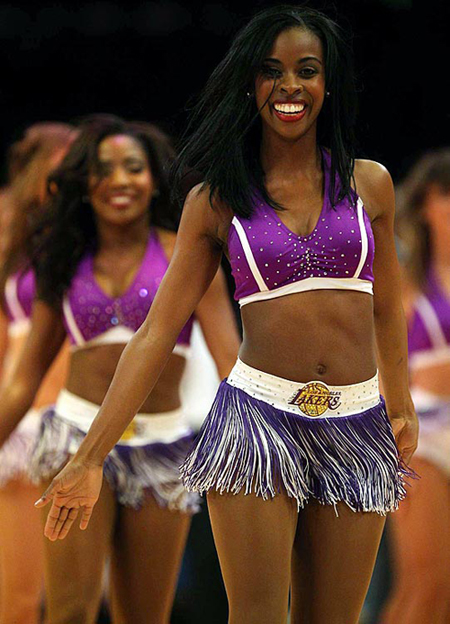
Being a Sea Gal entails just showing up on game day and dancing, right? Hardly. And the arduous task of making the 2012 squad begins with a series of workshops this month.
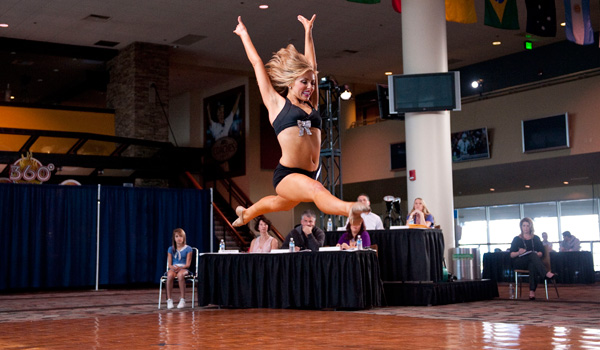
By Clare Farnsworth
Seahawks.com
Mar 9, 2012
There’s an old saying coaches use to describe an NFL season: It’s a marathon, not a sprint. The same could be said for becoming a Sea Gal. The members of the Seahawks dance team don’t just show up on game days and strut their stuff. Far from it.
Before the finals, there are auditions. And before the auditions, there are workshops. The marathon process is about to begin, again, as Sea Gals director Sherri Thompson oversees a process that will begin March 24 and conclude with the finals on May 6.
“You have to be serious about it and do all the necessary things to prepare,” said Sea Gal Laura, who has made the squad the past two years and is preparing to try out for a third time.
“I am really excited about auditions. It is nerve wracking being on the other side, now that I’ve been on the squad. Now, it’s not, ‘I hope I make it.’ Although obviously I hope I make it. But it’s more, ‘Oh my goodness, I would hate to miss out on what an amazing opportunity this is to be with such great women.’
“It’s so much more than just dancing on Sundays. Obviously, that’s my favorite part. But I feel I’ve really grown as a person being on the squad.”
As a returning member, Laura does not have to participate in the preliminary auditions – just the finals. But she is planning to take part in the workshops for the third consecutive year.
“In order to be confident throughout the audition process, if you can plan as much as you can that totally helps,” said Laura, 23, who is from Renton, went to Kentridge High School and now works as an executive assistant at a wealth management firm in Kirkland.
“Going to all the workshops and getting a feel for the style of dance that Sea Gal use is definitely something that will help through the audition process. And being able to come up with choreography on your own is really helpful, especially for the preliminary round of auditions.”
And speaking of marathon efforts, the first year Laura decided to try out for the squad she was a senior at Washington State University and completing her degree in psychology.
“I was planning all year to audition, so when the dates posted for auditioning I made the necessary plans to come over,” she said. “It was a lot of driving back and forth from Pullman. So if you ever need directions, I’m the girl.”
But it was extra work – and miles – that were well worth the effort.
“The more workshops they do, the better it is for them,” said Thompson, a former Sea Gal (1981-83) and choreographer (1984-86) who is now in her 26th year as the director.
Asked about the stress of the process, Laura offered, “I wouldn’t say it’s stressful, it’s just really exciting. In talking to people who play other sports and things like that, you just really have to commit and you really have to be passionate about what you’re doing.
“I’ve always been so passionate about dance and, having grown up in the Seattle area, I’ve always been passionate about the Seahawks. So if you have those two things, regardless of all of the other things that go into it, it almost makes it fun.”
If there’s an upside to all this effort put in by the participants, it’s that Thompson has a pretty good feel for who will be on the squad by the time the finals roll around. Or so it would seem.
“Yes I do, but there are always a handful of surprises – people that I thought for sure would make it, and then it just didn’t turn out in finals; and then all of a sudden there are those who bring it that night,” Thompson said.
“It always sets me back a little bit. I always walk away that finals night going, ‘Hmm. Thought I had it all figured out.”
But one thing rarely changes: To the hardest workers usually go spots on the 24-32 member squad.
“All that training works,” Thompson said. “But there are always surprises like that.”
Last week the Dallas Cowboys Cheerleaders appeared at a Peoria Rivermen hockey game, performing, signing autographs, and posing for photos with fans. Click here for photos.
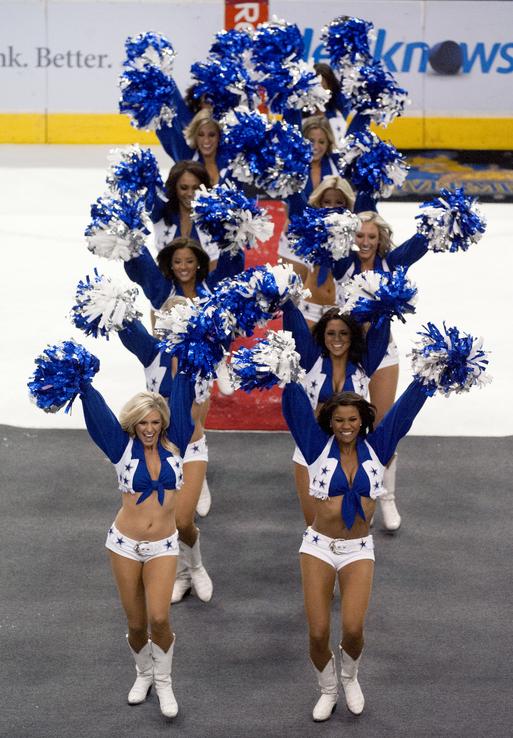
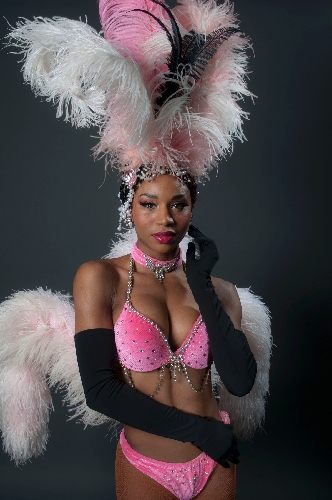 By John Przybys
By John Przybys
Las Vegas Review-Journal
Mar. 9, 2012
Q: Before moving here (last March), you were a Dallas Cowboys cheerleader. How long were you with the Cowboys?
A: Six years with the Cowboys.
Before that, I was with the Dallas Mavericks (dance team). I did three years with them.
Q: When did you start dancing?
A: My mom put me in it when I was in kindergarten. I was so shy. Like, if you tried to talk to me, I’d dig my face into my mom’s leg. That’s probably why I never did any extracurricular activities, because I would not socialize with the other kids. But my mom knew I was extremely athletic, naturally, and had an ability to dance, but I just would never do it.
Q: When did cheerleading enter the picture?
A: After my first year of college, my mom, because I never did cheerleading or anything like that, she saw an advertisement for the Dallas Cowboys cheerleaders. She said, “You should do it.” At the time, that was the furthest thing of being a reality for me. … I was, like, “They’re probably looking for tall, blond-haired, blue-eyed, big-boobed girls, and that’s not me.” She said: “Why don’t you try out and let the judges tell you no?”
Q: So you decided to go for it.
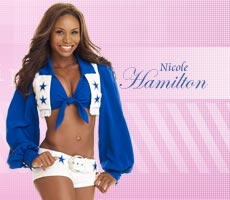 A: I spent three weeks doing all the studying and the research I could. And the first time I tried out, I was actually only one of the semifinalists. After that, for some reason, I was super encouraged and thought, “What’s next?” It turned out they had the Mavericks auditions in a couple of months. So I took six hours of dance a day and I ended up, at 19, making the Mavericks.
A: I spent three weeks doing all the studying and the research I could. And the first time I tried out, I was actually only one of the semifinalists. After that, for some reason, I was super encouraged and thought, “What’s next?” It turned out they had the Mavericks auditions in a couple of months. So I took six hours of dance a day and I ended up, at 19, making the Mavericks.
Q: And, three years later, you were chosen for the most iconic cheerleading squad in the world.
A: I was floored. And I was so motivated. … With (the Cowboys), it’s, like, rookie of the year, veteran of the year, you can be captain, you can be in the calendar, you can go to the Pro Bowl. There’s so much to strive for, and I’m, like, “I’m going to write a checklist, and I will accomplish this,” and by the end of my six years, I did all of them.
Q: And you’re on a Fathead (life-sized wall decal)!
A: I know! That’s super cool, too.
Q: Did they give you one?
A: I had to buy it. That’s another thing: I wanted to make show group, and I made show group my rookie year, and we did USO tours around the world. I’d watch them pass out my Fathead as the grand prize, and I’m, like, “You can’t give me one?” (Laughs)
Q: Has your cheerleading experience helped you transition to dancing into a Las Vegas show?
A: It helped, but it’s definitely a lot different. … When I was cheering, I was at the point of every formation every time, and you have to be bigger than life. … But, onstage, this style of dancing is not as big.
Q: Any idea what you might like to do when you’re finished performing?
A: I’m really starting to have a new passion for acting. … Just like being a model or an athlete is a short-lived career, I feel there is a lot of longevity in acting, and I could see that as another outlet for me to express myself.
Click here to check out photos of the Ice Crew in action at the Staples Center in Los Angeles.
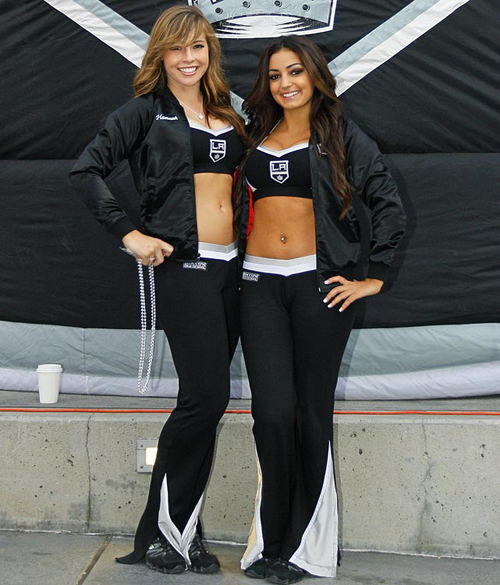
Written by Ayla Syed
Houston Baptist University
March 8, 2012
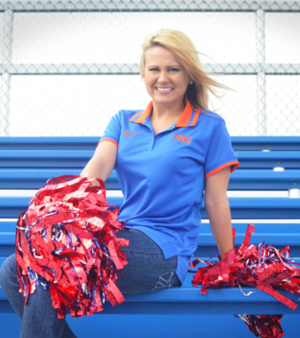
Amanda Golden, 26, a cheerleader for the Houston Texans, was hired as the new cheerleading coach. | photoillustration by MARYAM GHAFFAR/THE COLLEGIAN
Her furrows disappeared, however, when she mentioned the University’s new cheer director: a Houston Texans cheerleader.
“I think she can transition this team into a Division-I squad that can compete with teams from other schools,” Harding said. “Instead of being an extracurricular activity, the cheer squad can now be more of an athletic team.”
Amanda Golden, 26, was hired in mid-February to fill the vacant position and lead the squad of eight, two months before her last event as a professional cheerleader for the local National Football League team.
The squad’s last director, who oversaw many extracurricular activities as the assistant director of campus recreation, resigned from the University at the beginning of this year, leaving the squad with no coach. Golden, who starts on March 28, will serve as the first cheer director in recent years whose job is solely to work with the team.
Golden said she began applying for positions related to cheerleading this year because she thought it was her time to move on from professional cheerleading and that she found the University’s job opening listed online. “Five years is a long professional cheer career,” she said, adding that she has worked with the Texans since 2007. “I will miss performing with them, but I’m excited to begin working here.”
The Houston native began her tenure with the Texans’ squad at the age of 21 and has served as the captain for the last three years. Golden does not plan to reaffirm her position on the Texans’ squad as this year’s tryouts approach in April. She has instead begun preparing for the late-March University cheerleader tryouts that mark her official start date as a Husky and hopes to improve the campus cheer team.
“There is so much potential in the cheerleaders now,” she said. “They are so eager to learn. I want to help them strengthen their team.”
Golden plans to incorporate many aspects of professional cheerleading, such as rules similar to those she follows on the Texans’ squad, into her work at the University with the goal of building a competitive team. The squad does not currently participate in competitions.
Harding said she and Golden have the same vision for the future of the cheer squad as a competitive team and that she looks forward to working with the new coach. “It’s been tough without a director,” Harding said. “I’ve been cheering for 10 years but still need a coach whom I can turn to for help.”
Golden began taking dance classes at the age of 2 and cheering at the age of 12, leading up to the start of her Texans career. She continued her education while cheering professionally, graduating from the University of Houston-Clear Lake in 2009. She then began a part-time job as a commercial coordinator for Helix Energy Solutions Group, a Houston-based oil and gas company, where she will continue to work part time while coaching the Huskies.
Whit Goodwin, director of Student Life, who hired Golden, said her background and experience will benefit the University team.
“Her experience on the Texans’ squad will help bring a better work ethic and level of professionalism to the squad,” he said
The Memphis Grizzlies have updated their dance team pages. Click here to check it out!

Emily, Cara, and Kelsi

